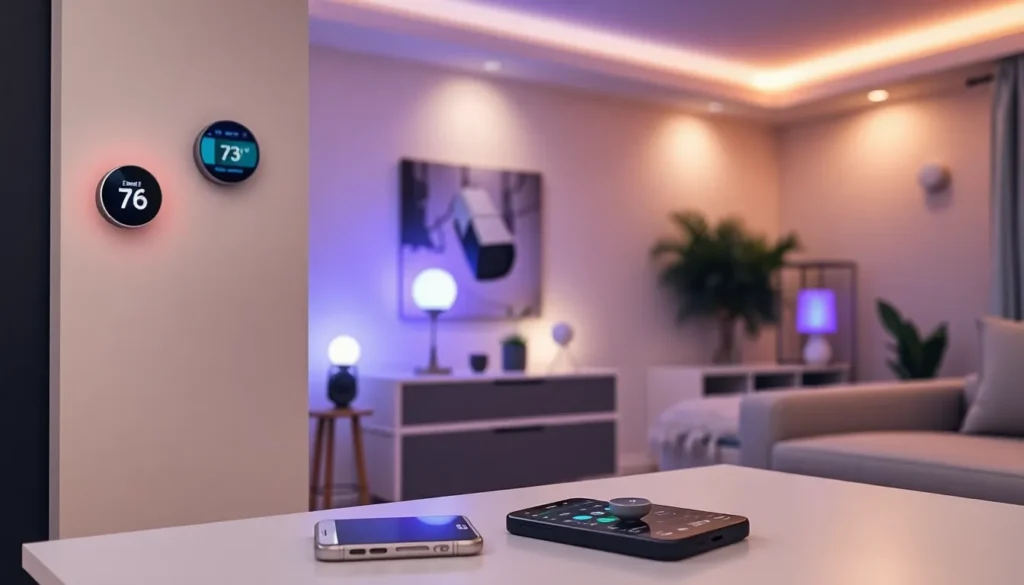Imagine walking into your home and having it respond to your every whim. Lights dim, temperature adjusts, and your favorite playlist kicks in—all without lifting a finger. Welcome to the world of smart home networking, where technology meets convenience in a way that makes even the Jetsons jealous.
In an age where everything from your fridge to your coffee maker can be connected, understanding smart home networking is essential. It’s not just about impressing your friends with your tech-savvy abode; it’s about creating a seamless, efficient living environment. So why not turn your home into a futuristic haven that not only caters to your needs but does so with a touch of humor? After all, who wouldn’t want a home that can crack a joke while brewing their morning coffee? Let’s dive into the ins and outs of smart home networking and unlock the potential of your digital domain.
Table of Contents
ToggleOverview of Smart Home Networking
Smart home networking enables seamless communication between devices within a home automation system. Integration of various technologies creates an interconnected environment, enhancing convenience and functionality. Devices such as smart thermostats, lights, and security cameras utilize this network to respond to user commands and preferences.
Multiple communication protocols, including Wi-Fi, Zigbee, and Z-Wave, allow devices to connect efficiently. Wi-Fi supports high-bandwidth tasks, while Zigbee and Z-Wave offer energy-efficient solutions for smaller devices. Homeowners can select the appropriate protocol based on specific needs, ensuring optimal performance.
Central hubs often manage smart devices, streamlining operations and simplifying user control. With a centralized system, users can monitor and adjust settings from a single point. A mobile app usually supports the hub, allowing access from anywhere.
Security remains a pivotal concern in smart home networking. Data encryption protects user information, while regular software updates address vulnerabilities. Employing secure passwords adds another layer of protection against unauthorized access.
In addition to communication and control, smart home networking often incorporates voice assistant technology. Devices compatible with platforms like Amazon Alexa or Google Assistant enable users to execute commands verbally. This functionality enhances user experience, providing a hands-free approach to home management.
Ultimately, smart home networking transforms daily routines into efficient processes. As technology continues to advance, users can expect even more integration capabilities and innovations, further enriching their smart home experience.
Benefits of Smart Home Networking

Smart home networking offers numerous advantages, enhancing daily life through technology integration. Two primary benefits include enhanced convenience and improved security.
Enhanced Convenience
Users experience significant convenience through smart home networking. Devices automatically adjust based on preferences, providing tailored environments. For example, smart thermostats learn user schedules, optimizing heating and cooling without manual input. Smart lights adapt to different settings, creating perfect atmospheres for activities like watching movies or entertaining guests. Centralized control through mobile apps simplifies device management, enabling users to monitor and adjust settings remotely. Voice-activated assistants streamline commands, allowing hands-free operation of various functions. This seamless integration reduces repetitive tasks, making daily routines more efficient and enjoyable.
Improved Security
Smart home networking significantly boosts security measures. Systems integrate multiple surveillance cameras and motion sensors, offering real-time monitoring of properties. Notifications alert homeowners to potential threats, ensuring timely responses to unusual activities. Data encryption safeguards personal information from unauthorized access. Regular software updates enhance system reliability, protecting against vulnerabilities. Strong password protocols add layers of security, minimizing risks. Many devices allow remote monitoring, giving homeowners peace of mind whether they are at home or away. Enhanced lighting features, such as timed lights, deter intruders, creating an impression of occupancy.
Key Components of Smart Home Networking
Smart home networking relies on several critical components that ensure seamless functionality and connectivity. Understanding these components enhances the effectiveness of home automation.
Smart Devices
Smart devices form the backbone of a smart home. Examples include smart thermostats that learn user preferences for climate control, smart lights that adjust brightness based on time of day, and security cameras that monitor property in real time. Each device connects to the home network and responds to user commands, creating an integrated and responsive environment. They are designed to interact with one another but often require a central hub for optimized performance. This hub streamlines the communication among the devices, allowing for centralized control and enhancing user experience.
Networking Infrastructure
A robust networking infrastructure supports smart home devices. This setup usually includes a reliable Wi-Fi router that communicates with devices using established protocols like Zigbee and Z-Wave. Multiple access points might enhance coverage throughout larger homes, minimizing dead zones. It’s essential to prioritize security features within the network, including strong passwords and regular updates, to protect sensitive information. Using Ethernet connections for stationary devices can improve speed and reliability. Effective networking ensures that all smart devices operate efficiently and responsively, ultimately enhancing the overall smart home experience.
Popular Smart Home Networking Protocols
Smart home networking relies on various protocols that enable devices to communicate effectively. Understanding these protocols ensures optimized performance and compatibility within smart environments.
Wi-Fi
Wi-Fi stands out as one of the most common smart home networking protocols. It allows devices like smart speakers, security cameras, and thermostats to connect directly to the internet. This direct access provides users with remote control options through mobile apps. Bandwidth limitations could affect performance if multiple devices connect simultaneously. Wi-Fi networks support high data transfer rates, making them ideal for streaming and larger data needs. Users can benefit from easy setup and integration with existing home networks.
Zigbee
Zigbee serves as a low-power, wireless protocol suited for smart home devices. This mesh networking protocol allows devices to communicate with one another, extending range and improving reliability. Zigbee’s low energy consumption makes it ideal for battery-powered devices like sensors and lights. Devices built on Zigbee can operate efficiently even in its dense environments. Manufacturers often use this protocol in smart bulbs, door locks, and motion detectors. Users enjoy enhanced connectivity and reliability, as Zigbee devices can relay messages through one another.
Z-Wave
Z-Wave presents another effective smart home networking protocol designed for low-power applications. It utilizes a mesh topology for robust communication, fostering connections between devices like smart locks, thermostats, and lights. Z-Wave’s unique advantage lies in its longer range compared to Zigbee, making it suitable for larger homes. Users benefit from fewer interference issues, as Z-Wave operates on a different frequency. The protocol also boasts high security, employing AES-128 encryption to protect user data. Homeowners appreciate its simplicity and compatibility with various devices, leading to smooth integration within smart home ecosystems.
Challenges in Smart Home Networking
Smart home networking faces several challenges that can hinder user experience and device performance.
Compatibility Issues
Compatibility issues arise when devices from different manufacturers can’t communicate effectively. Different protocols often create barriers, making it difficult for users to integrate all their smart devices. Homeowners may end up with a mix of devices that don’t work together seamlessly. A thorough evaluation of device specifications before purchasing can mitigate these issues. Choosing devices that support common protocols ensures smoother integration and enhances user satisfaction. Additionally, software updates might resolve compatibility problems over time, but this can be inconsistent across brands.
Security Vulnerabilities
Security vulnerabilities pose significant risks for smart home networks. Cyberattacks on poorly secured devices can expose sensitive data and compromise user safety. Most devices require strong passwords and regular updates to defend against threats, yet many users neglect this aspect. Encrypted communication channels provide an additional layer of protection, but certain devices may lack this feature. Employing strategies such as creating unique passwords and enabling two-factor authentication can enhance overall security. Users should prioritize devices and networks that meet high-security standards to safeguard their homes effectively.
Smart home networking represents a transformative shift in how individuals interact with their living spaces. By embracing this technology homeowners can enjoy enhanced convenience and security while simplifying daily routines. The integration of various devices and protocols creates a seamless environment that adapts to personal preferences.
As advancements continue to emerge in smart home technology the potential for innovation is limitless. Homeowners are encouraged to stay informed about the latest developments and best practices for securing their networks. Engaging with smart home solutions not only enriches everyday life but also paves the way for a more connected and efficient future.








